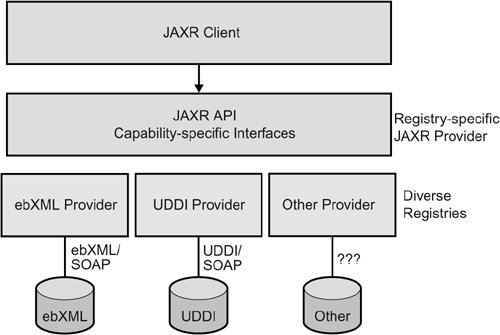Overview of JAXR
| This section provides a brief overview of JAXR. It covers the following topics:
What Is a Registry?An XML registry is an infrastructure that enables the building, deployment, and discovery of web services. It is a neutral third party that facilitates dynamic and loosely coupled business-to-business (B2B) interactions. A registry is available to organizations as a shared resource, often in the form of a web-based service. Currently there are a variety of specifications for XML registries. These include
A registry provider is an implementation of a business registry that conforms to a specification for XML registries. What Is JAXR?JAXR enables Java software programmers to use a single, easy-to-use abstraction API to access a variety of XML registries. A unified JAXR information model describes content and metadata within XML registries. JAXR gives developers the ability to write registry client programs that are portable across various target registries. JAXR also enables value-added capabilities beyond those of the underlying registries. The current version of the JAXR specification includes detailed bindings between the JAXR information model and both the ebXML Registry and the UDDI version 2 specifications. You can find the latest version of the specification at http://java.sun.com/xml/downloads/jaxr.html At this release of the Application Server, the JAXR provider implements the level 0 capability profile defined by the JAXR specification. This level allows access to both UDDI and ebXML registries at a basic level. At this release, the JAXR provider supports access only to UDDI version 2 registries. Currently no public UDDI registries exist. However, you can use the Java WSDP Registry Server, a private UDDI version 2 registry that came with release 1.5 of the Java Web Services Developer Pack (Java WSDP). Service Registry, an ebXML registry and repositry with a JAXR provider, is available as part of the Sun Java Enterprise System. JAXR ArchitectureThe high-level architecture of JAXR consists of the following parts:
A JAXR provider implements two main packages:
The most basic interfaces in the javax.xml.registry package are
The primary interfaces, also part of the javax.xml.registry package, are
When an error occurs, JAXR API methods throw a JAXRException or one of its subclasses. Many methods in the JAXR API use a Collection object as an argument or a returned value. Using a Collection object allows operations on several registry objects at a time. Figure 191 illustrates the architecture of JAXR. In the Application Server, a JAXR client uses the capability level 0 interfaces of the JAXR API to access the JAXR provider. The JAXR provider in turn accesses a registry. The Application Server supplies a JAXR provider for UDDI registries. Figure 191. JAXR Architecture |
